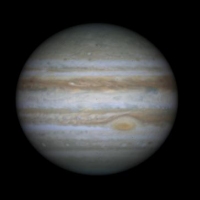Jupiter
 |
Origin of name
Satellites
ESA Missions |
Ulysses
Ulysses first flew by Jupiter in April 1998 and made use of Jupiter's gravitational pull to be put in an orbit with a high inclination to the ecliptic. The 6.2 year orbit makes it possible for Ulysses to study the Sun's polar regions.
Cassini-Huygens
Cassini-Huygens passed by Jupiter in December 2000 at a distance of 137 Jupiter radii. The energy that Cassini gained from this gravity assist was used to reach Saturn in July 2004.
Physical Properties
| Property | Unit | Value | Earth = 1 |
| Equatorial radius, 1 bar level | km | 71 492 | 11.209 |
| Polar radius, 1 bar level | km | 66 854 | 10.517 |
| Flattening | 0.06487 | 19.36 | |
| Mass (x1024) | kg | 1898.6 | 317.83 |
| Volume (x1010) | km3 | 143 128 | 1321.33 |
| Mean density | kgm-3 | 1326 | 0.240 |
| Gravity at equator, 1 bar level | ms-2 | 24.79 | 2.530 |
| Escape velocity | kms-1 | 59.5 | 5.32 |
| Magnetic field at equator (x10-4) | T | 4.28 | 14.03 |
| Magnetic dipole moment (x1020) | Tm3 | ~ 1.55 | ~ 20 000 |
| Tilt of dipole axis | ° | 9.6 | |
| Dipole field centre offset from planet centre (equatorial radii) | 0.14 | ||
| Number of natural satellites | 63 |
Orbital Parameters
| Property | Unit | Value |
| Perihelion (x106) | km | 740.52 |
| Aphelion (x106) | km | 816.62 |
| Mean distance from the Sun (x106) | km | 778.30 |
| Mean distance from the Sun | AU | 5.20 |
| Eccentricity | 0.0489 | |
| Sidereal orbit period | y | 11.862 |
|
Sidereal rotation period System III (1965.0) coordinates |
h | 9.9250 |
| Length of day | h | 9.9259 |
| Orbit inclination to Ecliptic | ° | 1.304 |
| Mean orbital velocity | kms-1 | 13.07 |
| Maximum orbital velocity | kms-1 | 13.72 |
| Minimum orbital velocity | kms-1 | 12.44 |
| Axial tilt | ° | 3.13 |
Notes
-
Sidereal orbit period
The time taken by the planet to complete exactly one orbit around the Sun with respect to the celestial sphere. -
Sidereal rotation period
The time in which the planet rotates around its axis exactly 360° with respect to the celestial sphere. -
Length of a day
Defined as the time between two successive sunrises over the meridian. -
Magnetic dipole moment
Calculated as the ratio of the magnetic field strength at the equator divided by the cube of the equatorial radius.
Last Update: 1 September 2019
